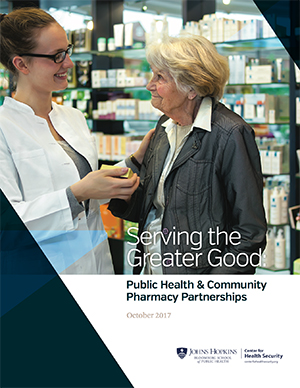Center for Health Security study highlights opportunities for pharmacies to help curb US opioid epidemic, bolster other public health efforts
Declining public health budgets and lingering physician shortages have created a healthcare gap. Helping to fill that gap requires modest changes to government policy that would unlock community pharmacy, long considered an untapped resource for improving public health.
Center News

November 08, 2017 – Strategic changes to government policy would present new opportunities for pharmacies in the United States to expand their already important role in critical initiatives that benefit public health, according to a study by the Johns Hopkins Center for Health Security and funded by the National Association of Chain Drug Stores (NACDS).
The study, “Serving the Greater Good: Public Health and Community Pharmacy Partnerships,” found the collective group of chain and independent US pharmacies remain an untapped resource in the effort to curb the national opioid crisis, stem the spread of antibiotic resistance, and strengthen pandemic and emergency preparedness and response. There is a growing public health need in these three key areas.
“When pharmacists are integrated into direct patient care in a team with other health professionals, there are positive effects on patient outcomes as well as reduced healthcare costs,” said Gigi Kwik Gronvall, PhD, senior associate at the Center and the study’s corresponding author. “What’s encouraging, though, is that more can be done to ensure pharmacy professionals practice at the ‘top of their license’—the peak of what they are capable and licensed to do to support public health.”
Changes to government policy headline myriad recommendations identified in the study that could have a significant positive impact on public health in the near future. Nowhere, though, is there a more immediate need to adjust policy in favor of community pharmacy than in the fight to curtail the opioid epidemic. For example, state-specific standing orders could be revised to permit pharmacists to dispense naloxone—a fast-acting drug that reduces the risk of respiratory failure after opioid overdose—without a prescription from a physician or nurse practitioner. Naloxone is FDA approved, is not a controlled substance, and is not addictive, yet only 23 states allow people to purchase naloxone at a pharmacy without a prescription. In addition, burdensome liability, payment, and legality issues in some states continue to limit a pharmacy’s role in opioid abuse intervention and education. Reform could contribute tremendously to the broader campaign to reduce opioid-related deaths, which accounted for 63 percent of all lethal US drug overdoses in 2015.
Meaningful reform is needed on other fronts as well. State regulatory authorities could implement innovative statewide protocols to expand pharmacists’ ability to provide patient testing and care, a move that would support work to address the spread of antibiotic resistance. More inclusive protocols could extend to pharmacists’ vaccination services, which would be an important resource in a flu pandemic or bioterror attack. Regulators could also collaborate across state lines to establish standardized protocols for integrating pharmacies into health emergency response to ensure displaced and underserved populations have access to basic care.
“The pharmacy community provides access to quality health care every day in communities across the nation. Pharmacies can serve as an even greater source of health policy and public health solutions, and we make that case at all levels and in all branches of government,” said NACDS President and CEO Steven C. Anderson, IOM, CAE. “We hope the recommendations in this report will foster new partnerships to address pressing needs, including the development of collaborative and comprehensive solutions for the opioid abuse epidemic. We are grateful to the Johns Hopkins Center for Health Security for its careful and thorough work on topics that ultimately will be of extraordinary benefit to public health in the United States.”
Pharmacists are already a valuable asset to public health. Look no further than their current role in curbing the opioid epidemic: They work on the front lines to help identify over-prescriptions, provide naloxone to patients at risk and those close to them (where legally permitted), foster awareness and solutions for the disposal of unused and unneeded medication, train for compliance with Drug Enforcement Administration regulations, and advance electronic prescribing to reduce fraud and abuse, and they are a highly accessible source of health information. Still, there is substantial opportunity to do more.
To develop its conclusions, the Center study team performed a literature review; held a day-long meeting of experts, including those from state medical associations, preparedness entities, community pharmacies, public health agencies, nonprofit organizations, and academia; and conducted additional consultations with pharmacy, preparedness, and public health experts. Gronvall’s coauthors on the study were Matthew Shearer, MPH, a senior analyst at the Center, Amesh Adalja, MD, a senior associate at the Center, and Ashley Geleta, MS, a former research assistant.
The full study is available here.
About the Johns Hopkins Center for Health Security:
The Johns Hopkins Center for Health Security works to protect people from epidemics and disasters and build resilient communities through innovative scholarship, engagement, and research that strengthens the organizations, systems, policies, and programs essential to preventing and responding to public health crises. The Center is part of the Johns Hopkins Bloomberg School of Public Health and is located in Baltimore, MD.
About the National Association of Chain Drug Stores:
NACDS represents traditional drug stores, supermarkets and mass merchants with pharmacies. Chains operate 40,000 pharmacies, and NACDS’ more than 100 chain member companies include regional chains, with a minimum of four stores, and national companies. Chains employ more than 3.2 million individuals, including 178,000 pharmacists. They fill over 3 billion prescriptions yearly, and help patients use medicines correctly and safely, while offering innovative services that improve patient health and healthcare affordability. NACDS members also include more than 850 supplier partners and over 60 international members representing 21 countries. Please visit nacds.org.
NACDS media contact:
Chris Krese
703-837-4650
ckrese@nacds.org
